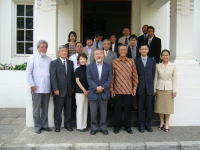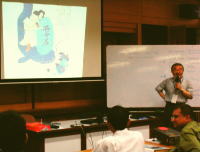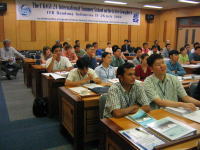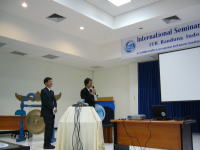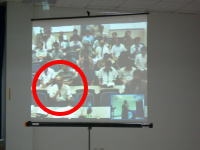Kazuo OIKE
July 14th, 2004 (Wednesday)
KAGI (Kyoto University Active Geosphere Investigation) (External Link) summer school, a COE program in 2003, was held with the cooperation of Indonesia's ITB (Institut Teknologi Bandung) . I attended on July 17th and delivered a talk.
On the day of my departure from Kansai International Airport, I went to the JAL lounge a little early in order to check my email. The honorary professors, Professor Susumu Kato and Professor Susumu Nishimura, who both live in Shiga Prefecture and have the same first name, had already arrived and a round of mutual introductions followed. Both professors are highly esteemed in Indonesia, Professor Nishimura in the field of geology and Professor Kato in upper atmosphere physics. They delivered a wealth of experience to those students who attended the summer school.
It was my first trip to Indonesia in about 15 years and so I had wanted to do a little research myself before my departure but, due to a lack of time, I found myself ready to board the plane without having uncovered anything new. My flight, JL713, departed at 14:30.
The Japanese archipelago looks out over the Pacific Ocean and the Philippine Sea, with the Asian continent and the intervening sea in the background. There are similarities with Japan in the positioning of Indonesia, which faces the Indian Ocean and in the west has a continental structure. The eastern part of Indonesia is geographically complex. In either direction, the islands of Indonesia are very similar to Japan in many ways, being positioned in a tectonic belt of East Asia where plate tectonics operate to cause volcanic eruptions, earthquakes and tidal waves. Here, the seminar on the active geosphere was attended by 50 young participants from East Asia and Oceania.
I touched down at Denpasar Airport on Bali, arriving in Bali on Bastille Day. The airport is a large one and so I spent about 45 minutes in the transit passenger area walking through the stores. One Japanese yen was fetching 80 rupiahs at the bank and so I changed some currency. I boarded the plane again and arrived in Jakarta at 23:55 Japan time, 21:55 Indonesia time. The exchange rate at the bank at Jakarta Airport was 75 rupiahs for one Japanese yen. The flight from Denpasar to Jakarta is basically in a westerly direction and so I could see the Southern Cross from the left-hand side of the plane.
Professor Shujo Takemoto, who is in charge of the summer school, and Yumi Kitamura of the Jakarta Office, the Center for Southeast Asian Studies, were there to meet me on my arrival at Soekarno-Hatta International Airport. Professor Kato and Professor Nishimura had a different itinerary in Bandung.
July 15th (Thursday)
I visited the Jakarta Office of the Center for Southeast Asian Studies, (External Link) and then the Embassy of Japan. The office is situated in a residential area in front of a shop that sells flower wreaths for funerals. This is the workplace of Ms. Kitamura, whose specialty is library science. She showed me a collection of the candidate goods that had been widely circulated at the time of the presidential election. It was very interesting.
Next I visited the Embassy of Japan. I passed a stringent security check before entering the rooms of the ambassador. There I met Ambassador Extraordinary and Plenipotentiary Yutaka Iimura. He gave his regards to the Jakarta Office of the Center for Southeast Asian Studies and we discussed how the structure of the Sunda archipelago is very similar to the Japanese archipelago as they are both located on the tectonic belts. The ambassador showed great interest, saying he would like to use some of the information in a lecture sometime.
I then traveled overland through the Puncak pass heading towards Bandung. This turned out to be a pleasant journey, as we moved slowly through congested traffic while I took in the scenery. I traveled to Bandung accompanied by Saki Murano, a postgraduate student of the Graduate School of Asian and African Area Studies (External Link) . She was staying in Indonesia to do research on the national constitution and changes in the health policy.
July 16th (Friday)
I paid a visit to Kusmayanto Kadiman, the Rector of the ITB (Institut Teknologi Bandung) at 8 o'clock. Sri Widiyantoro, who obtained his degree at the Kyoto University School of Science, and Emmy Suparka, the Dean of Mineral Technology in the Geoscience Faculty, were joined by Takemoto, Yoda, Setoguchi, Mori, Tsuda, and Murakami of Kyoto University. We expressed our gratitude to Rector Kusmayanto for handling the summer school and discussed the long history of cooperation between our universities. He then asked me to call him "Kusu", so I explained to him that "Kusu" is the emblem of Kyoto University in Japanese. I also suggested that it would be great if both our universities could engage in further academic cooperation in the future, and he agreed sincerely.
After that I had a talk with some students in the lecture room, as we discussed what "earthquakes" are called in different countries.
In the afternoon I attended a joint research meeting with research planning for the Research Institute for Sustainable Humanosphere (External Link) with Tsuda and Imamura and we held discussions with researchers from the LIPI (Indonesian Institute of Sciences) and LAPAN (National Institute of Aeronautics and Space) .
July 17th (Saturday)
The international symposium was attended by many people. Mr. Yoda, somebody in the place of Rector Kusmayanto, and myself each delivered greetings. Professor Widiyantoro of ITB and Vice President Irikura of the Kyoto University exchanged opinions with each other to further links between our respective organizations, Bundung and Kyoto (the lecture room at Kyoto University) . Mr. Irikura also held discussions with Dr. Edwan Kardena, Assistant Director of Partnerships, aimed at deepening scientific exchange between ITB and Kyoto University.
In the afternoon I once again headed north from Bandung to visit the Rempang fault. I saw the mouth of Tangkuban Prahu volcano. The crater was quiet, however, wrapped in a smoldering mist.
In the evening, a reception was held in a large conference room of ITB. I gave a brief message at the gathering and told them about songs I remembered from the time when I had done some fieldwork in the region, and sang "Bungawansoro" from Java Island to provide it. Rector Kusmayanto talked about the history of the University. This was followed by some Sundanese music and dance and some traditional Sundanese cuisine with juice and water beverages. There were fifty young students attending the summer school and together with the scholars participating in the symposium we had a wonderful time.
July 18th (Sunday)
On Sunday, I traveled by train from Bandung to Jakarta. Murakami, Yoko, and I were accompanied by Professor Mori of the Disaster Prevention Research Institute. We met up with Miyako Koizumi at the Jakarta office. As a postgraduate student of the Graduate School of Asian and African Area Studies, she is doing research on the plant classification systems and the usage of plants of the Punan Bunairu hunter gatherer people in East Kalimantan.
While waiting for the night flight, JL714, I went out to take a look at the fish market, Muara Katang, in the north eastern part of Jakarta. My driver and a helper from the Jakarta office came with me to help me in skillfully selecting a fish. It was great to hear Murakami conversing with the driver Jopi in Indonesian. I selected a few fish like bream, and some shrimps and squids and took them to a restaurant where they were cooked over palm tree husk coals. Murano, Koizumi, Mori, the helper from the office, and Jopi all dined together that evening. After flooding at the port, the roads were submerged, and that was causing everyone a lot of trouble, but the fish was delicious.
That night, as I put this report together I flew out over the Sunda archipelago, known as the Emerald Necklace, and as dawn broke I returned home, on a night flight through the skies over the Japan Archipelago known as the Flower Archipelago.


